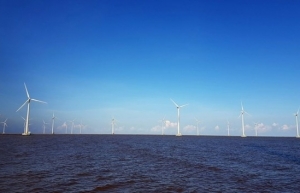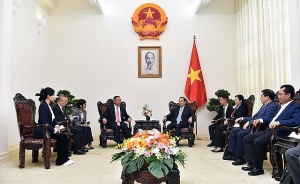Renewable energy and future challenges for JICA
The success story of the plant was also applied to other projects of ours, such as Ham Thuan-Da Mi Hydropower Plant (completed in 2001), and Dai Ninh Hydropower Plant (completed in 2008). Both were also utilised for irrigation, which contributed to the promotion of agriculture in the southern region.
 |
| Kubo Yoshitomo, Senior Vietnam office representative Japan International Cooperation Agency |
In order to achieve ambitious net-zero targets, Vietnam requires huge development including large investments in new and renewable energy as well as capacity building.
Due to the low rainfall this year which dried hydroelectric dams in the north, severe power outages have occurred in various places, especially at industrial parks. Since there would be no plan for new coal-fired plants despite the need for baseload expansion, Vietnam’s Power Development Plan VIII aims to increase power generation to 22,400MW by 2030 through gas power.
Besides this, the potential for additional development in hydropower generation is limited as solutions, including expansion of the existing storage dams and irrigation dams for power generation, have been mostly carried out.
Under these circumstances, renewable energy has widely been introduced on a private-sector basis, and offshore wind will be important for further expansion. For the realisation of offshore wind, the establishment of a legal framework and pricing mechanism must be seriously considered as soon as possible.
We have also been supporting projects in new renewable energies such as solar and wind power generation in recent years using a private sector investment finance scheme. Together with other development agencies and private banks, we co-financed a solar power generation project in Phu Yen province and wind power projects in Quang Tri and Ninh Thuan provinces.
Regarding the increase in storage capacity, such as battery storage and pumped storage for power generation, the key issue is the development of an appropriate pricing mechanism for ancillary services. For this, the promotion of private investment by institutionalising an appropriate price mechanism based on market principles is strongly advised.
In addition to that, the power grid network needs to be strengthened in line with the increase in renewable energy. In consideration that power shortages are occurring mainly in the north and renewable energy development progresses are being made in the south, the backbone transmission between the two regions is required. This would help to enable the usage of surplus power from the south in the north, and create a nationwide development impact.
Different from the development of power plants, it is difficult for the private sector to develop power grid reinforcement. In this context, the support of official development assistance (ODA) to this area is considered essential.
As a matter of fact, the complicated procedures determined by Decree No.114/2021/ND-CP, which limit the areas where donors can provide support, is a substantial bottleneck for the efficient use of ODA. In particular, according to the decree, the executing agency of each project needs to specify a line agency in their proposal for the implementation of ODA projects.
Nevertheless, the line agency for subsidiaries of Vietnam Electricity, including the National Power Transmission Corporation, which is responsible for the development of the nationwide power grid, has not been legally recognised in the current situation. Eventually, there are frequent cases where development opportunities are missed as ODA cannot be applied by the stipulations of Decree 114.
Currently, grid network capacity does not match the large-scale introduction of renewable energy. Therefore, the Vietnamese government has been asked to clarify its direction in promoting energy transition specifically in areas that show urgent needs for grid enhancement, since this would help the absorbance of excess electricity generated by wind and solar photovoltaic energy.
Although the Vietnamese government considers it too early to develop high-capacity north-south power transmission lines, given the required period for project preparation and lengthy approval process, the discussion about the new project of strengthening the power grid network nationwide should be put on the table soon.
Since Vietnam has achieved steady economic growth lately, it is essential to establish a stable power supply system to meet the rapid increasing demand of electricity. Considering the geographical characteristics of Vietnam, the development potential of renewable energy is highly evaluated, and it is strongly expected that the aforementioned issues would be promptly solved with strong action from the government.
 | Singapore to import 1.2GW of low-carbon energy from Vietnam Singapore’s Energy Market Authority (EMA) on October 24 announced that it has given tentative approval for plans to import 1.2 gigawatts (GW) of primarily wind-generated electricity from Vietnam. |
 | 24 renewable projects show interest in direct power purchase agreement 24 renewable energy projects with a combined capacity of 1,773MW have expressed interest in participating in a pilot scheme for a direct power purchase agreement (DPPA) in Vietnam, according to the Ministry of Industry and Trade (MoIT) in a report submitted to Prime Minister Pham Minh Chinh las week. |
 | Trina Solar to invest additional $420 million in Thai Nguyen Trina Solar, a Chinese enterprise in photovoltaic module and smart energy solutions, decided to inject an additional $420 million into its ongoing projects in the northern province of Thai Nguyen. |
What the stars mean:
★ Poor ★ ★ Promising ★★★ Good ★★★★ Very good ★★★★★ Exceptional
Related Contents
Latest News
More News
- Global partnerships key to Vietnam’s IFC development (December 26, 2025 | 16:18)
- Vingroup pulls out of bid to invest in North-South high-speed railway (December 26, 2025 | 11:42)
- Strengthening supply chains through trade promotions and customs reform (December 24, 2025 | 14:00)
- PM orders investment model for North–South high-speed rail (December 22, 2025 | 17:43)
- LS Eco Energy to invest in Vietnam rare earth sector (December 22, 2025 | 17:31)
- Government moves to establish International Financial Centre (December 21, 2025 | 21:00)
- Vietnam's IFC to target global investment flows (December 21, 2025 | 18:00)
- Two national hospitals expand capacity with new facilities (December 20, 2025 | 09:00)
- Ha Tinh breaks ground on major Vingroup industrial and energy projects (December 19, 2025 | 18:24)
- EVN launches major power infrastructure projects nationwide (December 19, 2025 | 18:17)

 Tag:
Tag:





















 Mobile Version
Mobile Version